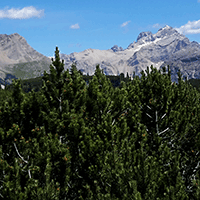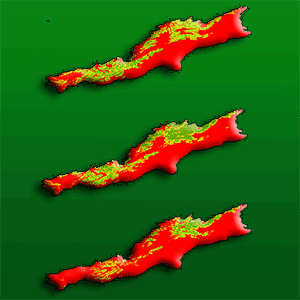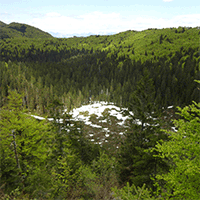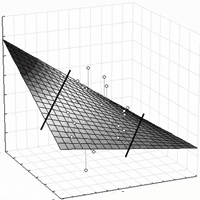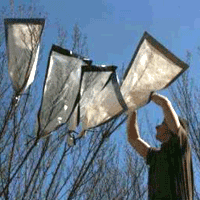Juniperus excelsa is one of the most common tree species and has a wide geographical and altitudinal distribution in Turkey. It is also resistant to drought and frost damages and can cope with poor soils. In this study, we explore whether there are any differences among eight J. excelsa populations from a narrow geographic region grown in a common garden test site in terms of growth and contents of photosynthetic pigments, proline and nutrients of their 10-year-old saplings. Phenotypic trait differentiation (QST) at all traits, FST at neutral SSRs among six of the populations and associations of traits with environmental conditions at provenance regions were also analysed to test for patterns of local adaptation. Sapling traits of eight J. excelsa populations of from Lakes District in Turkey at the test site showed that populations significantly differed for growth, photosynthetic pigments, proline and nutrient contents. The mean height and diameter of 10-year-old saplings were found as 94.5 cm and 41.6 mm, respectively. Egirdir-Barla and Sütçüler-Tota populations showed the highest performance for the majority of traits at age 10 compared to all other populations. Nutrient contents in leaves were generally in the sufficiency range reported for plant growth. Considering photosynthetic pigments and proline, it could be concluded that the populations were not exposed to severe stress. Among the environmental variables, the best predictors of growth were annual mean minimum temperature and soil texture at the populations’ origin, accounting for 49% of the variation in height and diameter, respectively. Also, higher phenotypic trait differentiation for most traits than genetic differentiation at neutral genetic markers suggests local adaptation at a small geographic scale. The present study revealed adaptive divergence between populations at a small geographic scale. However, environmental similarity between region of origin and test site was not a good indicator of growth-related traits. The results can be used in the early selection of provenances for J. excelsa for plantation establishment.
Keywords
, , , ,
Citation
Yücedag C, Çiçek N, Gailing O (2021). Local adaptation at a small geographic scale observed in Juniperus excelsa populations in southern Turkey. iForest 14: 531-539. - doi: 10.3832/ifor3769-014
Academic Editor
Marco Borghetti
Paper history
Received: Jan 29, 2021
Accepted: Sep 21, 2021
First online: Nov 24, 2021
Publication Date: Dec 31, 2021
Publication Time: 2.13 months
© SISEF - The Italian Society of Silviculture and Forest Ecology 2021
Open Access
This article is distributed under the terms of the Creative Commons Attribution-Non Commercial 4.0 International (https://creativecommons.org/licenses/by-nc/4.0/), which permits unrestricted use, distribution, and reproduction in any medium, provided you give appropriate credit to the original author(s) and the source, provide a link to the Creative Commons license, and indicate if changes were made.

Breakdown by View Type
(Waiting for server response...)
Article Usage
Total Article Views: 30851
(from publication date up to now)
Breakdown by View Type
HTML Page Views: 26414
Abstract Page Views: 2072
PDF Downloads: 1849
Citation/Reference Downloads: 3
XML Downloads: 513
Web Metrics
Days since publication: 1478
Overall contacts: 30851
Avg. contacts per week: 146.11
Article Citations
Article citations are based on data periodically collected from the Clarivate Web of Science web site
(last update: Mar 2025)
Total number of cites (since 2021): 5
Average cites per year: 1.00
Publication Metrics
by Dimensions ©
Articles citing this article
List of the papers citing this article based on CrossRef Cited-by.
(1)
Anonymous (2013)Illere ait mevsim ortalamalari (1970-2011) [Seasonal averages of provinces (1970-2011). Web Site.
Online |
Gscholar
(2)
Apostol EN, Stuparu E, Scarlatescu V, Budeanu M (2020)Testing Hungarian oak (
Quercus frainetto Ten.) provenances in Romania. iForest - Biogeosciences and Forestry 13: 9-15.
CrossRef |
Gscholar
(3)
Ashraf MA, Iqbal M, Rasheed R, Hussain I, Perveen S, Mahmood S (2018)Dynamic proline metabolism: importance and regulation in water-limited environments. In: “Plant Metabolites and Regulation Under Environmental Stress” (Ahmad P, Ahanger MA, Singh VP, Tripathi DK, Alam P, Alyemeni MN eds). Academic Press, San Diego, CA, USA, pp. 323-336.
CrossRef |
Gscholar
(4)
Barbati A, Scarascia Mugnozza G, Ayan S, Blasi E, Calama R, Canaveira P, Cicatiello C, Collalti A, Corona P, Del Rio M, Ducci F, Perugini L (2018)Adaptation and mitigation. In: “State of Mediterranean Forests 2018” (Bourlion N, Garavaglia V, Picard N eds). FAO, Rome, Italy and Plan Bleu, Marseille, France, pp. 128-146.
Online |
Gscholar
(5)
Bates L, Waldren RP, Teare ID (1973)Rapid determination of free proline for water-stress studies. Plant and Soil 39: 205-207.
CrossRef |
Gscholar
(6)
Boshier D, Stewart J (2005)How local is local? Identifying the scale of adaptive variation in ash (
Fraxinus excelsior L.): results from the nursery. Forestry 78: 135-143.
CrossRef |
Gscholar
(7)
Brancalion PHS, Rodrigues RR, Oliveira GCX (2015)When and how could common gardens be useful in the ecological restoration of long-lived tropical plants as an aid to the selection of seed sources? Plant Ecology and Diversity 8: 81-90.
CrossRef |
Gscholar
(8)
Carter KK (1996)Provenance tests as indicators of growth response to climate change in 10 north temperate tree species. Canadian Journal of Forest Research 26: 1089-1095.
CrossRef |
Gscholar
(9)
Chakraborty D, Wang T, Andre K, Konnert M, Lexer MJ, Matulla C, Schueler S (2015)Selecting populations for non-analogous climate conditions using universal response functions: The case of Douglas-fir in Central Europe. PLoS One 10 (8): e0136357.
CrossRef |
Gscholar
(10)
Cetin M (2014)Burdur çevresi agaçlandirma ve erozyon kontrolü çalismalarinin degerlendirilmesi [Evaluation of afforestation and erosion control works around Burdur]. Publications of the General Directorate of Combating Desertification and Erosion, Ankara, Turkey, pp. 182. [In Turkish]
Gscholar
(11)
Douaihy B, Vendramin GG, Boratynski A, Machon N, Dagher-Kharrat MB (2011)High genetic diversity with moderate differentiation in
Juniperus excelsa from Lebanon and the eastern Mediterranean region. AoB Plants 2011: plr003.
CrossRef |
Gscholar
(12)
Douaihy B, Sobierajska K, Jasinska AK, Boratynska K, Ok T, Romo A, Machon N, Didukh Y, Dagher-Kharrat MB, Boratynski A (2012)Morphological
versus molecular markers to describe variability in
Juniperus excelsa subsp.
excelsa (Cupressaceae). AoB Plants 2012: pls013.
CrossRef |
Gscholar
(13)
Eler U (1988)Türkiye’de boylu ardiç (Juniperus excelsa Bieb.) ormanlarinda hasilat arastirmalari [Yield studies for Crimean juniper (
Juniperus excelsa Bieb.) forests in Turkey]. Publications of Forestry Research Institute, Ankara, Turkey, pp. 70. [In Turkish]
Gscholar
(14)
Erinç S (1965)Yagis müessiriyeti üzerine bir deneme ve yeni bir indis [An essay on the effectiveness of precipitation and a new index]. Publications of Geography Institute of Istanbul University, Istanbul, Turkey, pp. 51. [In Turkish]
Gscholar
(15)
FAO (2020)Soil testing methods. Food and Agriculture Organization, United Nations, Rome, Italy, web site.
Online |
Gscholar
(16)
Fowells HA, Means JE (1990)The tree and its environment. In: “Silvics of North America” (Burns RM, Honkala BH eds). USDA Forest Service, Washington, DC, USA, pp. 2-11.
Online |
Gscholar
(17)
Gülser F, Türkoglu N, Cig A (2013)The determination of nutrient contents of native juniper (
Juniperus excelsa Bieb) leaves related with soil properties in Van region. In: Proceedings of the “International Caucasian Forestry Symposium”. Artvin (Turkey) 24-26 Oct 2013, pp. 570-573.
Online |
Gscholar
(18)
Gulsoy AD, Gulsoy AM, Duman H, Kaya Z (2012)Molecular phylogeny of
Juniperus species in Turkey based on noncoding trn region of cpDNA. In: Proceedings of the “International Symposium on the Biology of Rare and Endemic Plant Species (BIORARE 2012)”. Mugla (Turkey), 23-27 April 2012, pp. 39.
Gscholar
(19)
Hill WG, Goddard ME, Visscher PM (2008)Data and theory point to mainly additive genetic variance for complex traits. PLoS Genetics 4: 1-10.
CrossRef |
Gscholar
(20)
Hojjati F, Zarre S, Assadi M (2009)Isoenzyme diversity and cryptic speciation in
Juniperus excelsa (Cupressaceae) complex in Iran. Biochemical Systematics and Ecology 37: 193-200.
CrossRef |
Gscholar
(21)
Isaac-Renton M, Montwé D, Hamann A, Spiecker H, Cherubini P, Treydte K (2018)Northern forest tree populations are physiologically maladapted to drought. Nature Communications 9 (1): 987.
CrossRef |
Gscholar
(22)
Jayasankar S, Sudhakara K, Babu LC (2003)Provenance variation in growth, physiology, anatomical characteristics and foliar nutrient status of teak (
Tectona grandis) seedlings. Journal of Tropical Forest Science 15 (1): 37-50.
Online |
Gscholar
(23)
Keles Y, Everest A (2008)Relation to altitude adaptation and antioxidant defense system in five shrubs and trees species from middle Taurus Mountains. International Journal of Natural and Engineering Sciences 2: 45-49.
Gscholar
(24)
Kilinç M, Kutbay HG, Yalçin E, Bilgin A (2006)Bitki ekolojisi ve bitki sosyolojisi uygulamalari [Plant ecology and plant sociology applications]. Palme Publishing, Ankara, Turkey, pp. 362. [In Turkish]
Gscholar
(25)
Kjeldahl J (1883)New method for the determination of nitrogen. Chemistry News 48 (1240): 101-102.
Gscholar
(26)
Klein T, Di Matteo G, Rotenberg E, Cohen S, Yakir D (2012)Differential ecophysiological response of a major Mediterranean pine species across a climatic gradient. Tree Physiology 33: 26-36.
CrossRef |
Gscholar
(27)
Krishan B, Toky OP (1995)Variation in foliar biochemical and nutrient contents among provenances of
Acacia nilotica ssp.
indica. Journal of Tropical Forest Science 8 (1): 78-86.
Online |
Gscholar
(28)
Leites LP, Robinson AP, Rehfeldt GE, Marshall JD, Crookston NL (2012)Height-growth response to climatic changes differs among populations of Douglas-fir: a novel analysis of historic data. Ecological Applications 22 (1): 154-165.
CrossRef |
Gscholar
(29)
Li Y, Wu X, Chen T, Wang W, Liu G, Zhang W, Li S, Wang M, Zhao C, Zhou H, Zhang G (2018)Plant phenotypic traits eventually shape its microbiota: a common garden test. Frontiers in Microbiology 9: 2479.
CrossRef |
Gscholar
(30)
Li Y-S, Shih K-M, Chang C-T, Chung J-D, Hwang S-Y (2019)Testing the effect of mountain ranges as a physical barrier to current gene flow and environmentally dependent adaptive divergence in
Cunninghamia konishii (Cupressaceae). Frontiers in Genetics 10: 742.
CrossRef |
Gscholar
(31)
Lichtenthaler HK (1987)Chlorophylls and carotenoids: pigments of photosynthetic biomembranes. Methods in Enzymology 148: 350-382.
CrossRef |
Gscholar
(32)
Manzanedo RD, Schanz FR, Fischer M, Allan E (2018)Fagus sylvatica seedlings show provenance differentiation rather than adaptation to soil in a transplant experiment. BMC Ecology 18 (1): 669.
CrossRef |
Gscholar
(33)
Miller RO (2004)High-temperature oxidation: Dry ashing. In: “Handbook of Reference Methods for Plant Analysis” (Kalra YP ed). CRC Press, Florida, USA, pp. 53-56.
CrossRef |
Gscholar
(34)
Oleksyn J, Modrzynksi J, Tjoelker MG, Zytkowiak R, Reich PB, Karolewski P (1998)Growth and physiology of
Picea abies populations from elevational transects: common garden evidence for altitudinal ecotypes and cold adaptation. Functional Ecology 12: 573-590.
CrossRef |
Gscholar
(35)
Ortel E, Kavgaci A, Calikoglu M, Türkkan M, Gültekin HC, Cobanoglu A (2020)Boylu ardicin (
Juniperus excelsa) yapay gençlestirilmesi [Artificial regeneration of Crimean juniper (
Juniperus excelsa)]. Turkish Journal of Forestry Research 7 (1): 22-30. [in Turkish]
Gscholar
(36)
Pakharkova N, Borisova I, Sharafutdinov R, Gavrikov V (2020)Photosynthetic pigments in Siberian pine and fir under climate warming and shift of the timberline. Forests 11: 1-15.
CrossRef |
Gscholar
(37)
Qin C-Z, Zhu A-X, Pei T, Li B-L, Scholten T, Behrens T, Zhou C-H (2011)An approach to computing topographic wetness index based on maximum downslope gradient. Precision Agriculture 12: 32-43.
CrossRef |
Gscholar
(38)
Rout GR, Sahoo S (2015)Role of iron in plant growth and metabolism. Reviews in Agricultural Science 3: 1-24.
CrossRef |
Gscholar
(39)
Sáenz-Romero C, Kremer A, Nagy L, Ujvari-Jarmay E, Ducousso A, Koczan-Horvath A, Hansen JK, Matyas C (2019)Common garden comparisons confirm inherited differences in sensitivity to climate change between forest tree species. Peer J - Life and Environment 7: 6213.
CrossRef |
Gscholar
(40)
Schreiber P (1904)Uber die Beziehungen zwischen dem Niederschlag und der Wasserführung der Flüsse in Mitteleuropa [The relationship between precipitation and the water flow of rivers in Central Europe]. Meteorologische Zeitschrift 21: 441-452. [in German]
Gscholar
(41)
Semerci A, Semerci H, Caliskan B, Ciçek N, Ekmekçi Y, Mencuccini M (2017)Morphological and physiological responses to drought stress of European provenances of Scots pine. European Journal of Forest Research 136: 91-104.
CrossRef |
Gscholar
(42)
Sewenet HK (2019)A review on comparison of complete and incomplete block designs. Journal of Biology, Agriculture and Healthcare 9 (9): 15-24.
Online |
Gscholar
(43)
Shah SH, Houborg R, McCabe MF (2017)Response of chlorophyll, carotenoid and SPAD-502 measurement to salinity and nutrient stress in wheat (
Triticum aestivum L.). Agronomy 7: 61.
CrossRef |
Gscholar
(44)
Shtangeeva I, Tesfalidet S, Lövgren L (2017)Comparison of nutrient concentrations in leaves of five plants, Journal of Plant Nutrition 40: 239-247.
CrossRef |
Gscholar
(45)
Sillanpaeae M (1991)Micronutrient assessment at the country level: an international study. FAO, Rome, Italy, pp. 214.
Gscholar
(46)
Spitze K (1993)Population structure in
Daphnia obtuse - quantitative genetic and allozymic variation. Genetics 135: 367-374.
CrossRef |
Gscholar
(47)
Turner J, Dice SF, Cole DW, Gessel SP (1977)Variation of nutrients in forest tree foliage. Publications of University of Washington, Seattle, Washington, USA, pp. 31.
Online |
Gscholar
(48)
Vizcaíno-Palomar N, Garzón MB, Alia R, Giovannelli G, Huber G, Mutke S, Pastuszke P, Raffin A, Sbay H, Seho M, Vauthier D, Fady B (2019)Geographic variation of tree height of three pine species (
Pinus nigra Arn.,
P. pinaster Aiton, and
P. pinea L.) gathered from common gardens in Europe and North-Africa. Annals of Forest Science 76: 77.
CrossRef |
Gscholar
(49)
Wilczynski S, Kulej M (2019)The growth of seven
Abies grandis provenances in the climatic conditions of the Polish Carpathian Mountains. Dendrobiology 81: 1-13.
CrossRef |
Gscholar
(50)
Yücedag C, Gailing O (2013a)Genetic variation and differentiation in
Juniperus excelsa M. Bieb. populations in Turkey. Trees - Structure and Function 27: 547-554.
CrossRef |
Gscholar
(51)
Yücedag C, Gailing O (2013b)Differences among
Juniperus excelsa populations as revealed at morphological traits. Dendrobiology 70: 65-72.
CrossRef |
Gscholar
(52)
Zvezdanovic J, Markovic D (2009)Copper, iron, and zinc interactions with chlorophyll in extracts of photosynthetic pigments studied by VIS spectroscopy. Russian Journal of Physical Chemistry A 83: 1542-1546.
CrossRef |
Gscholar


